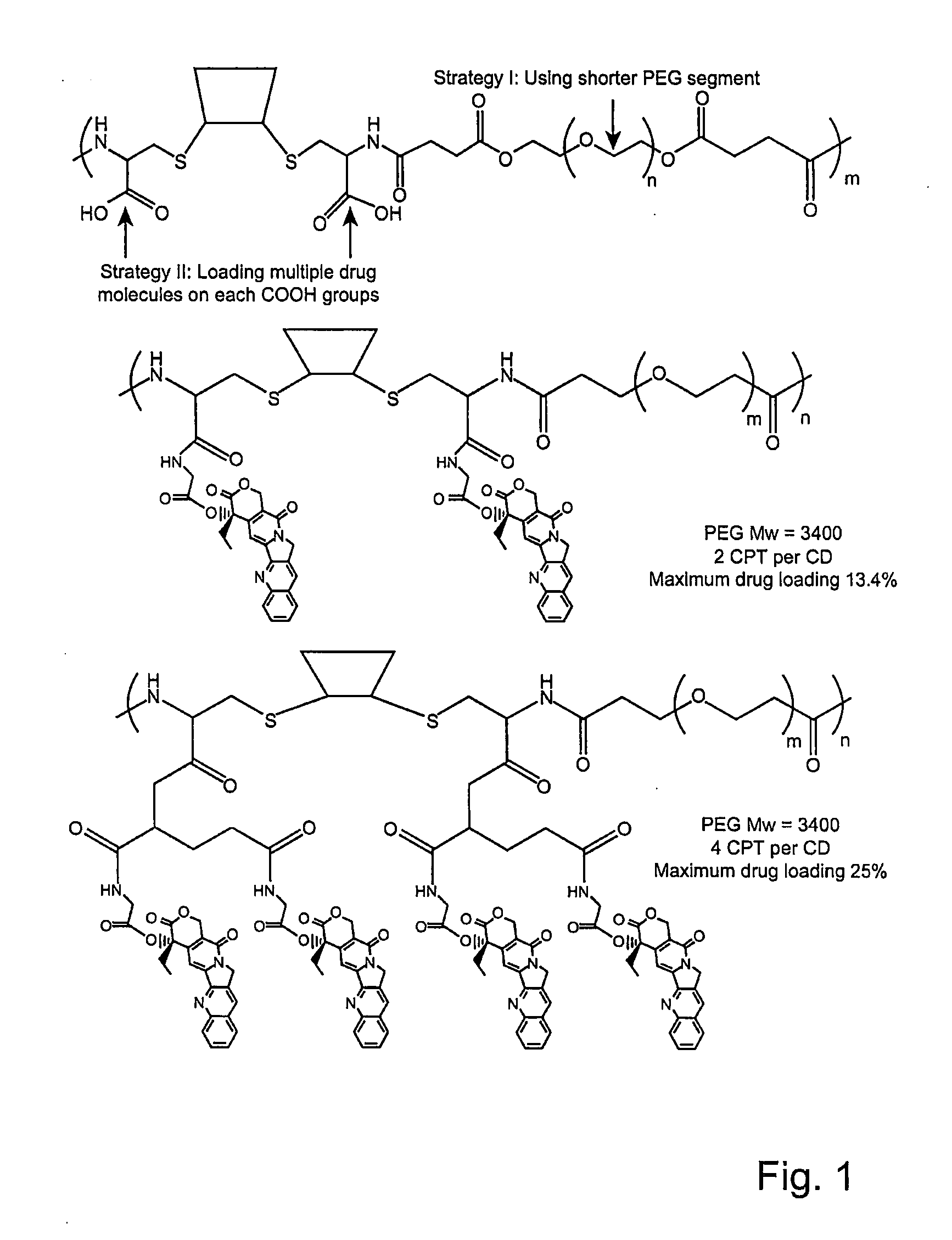Cyclodextrin-based polymers for therapeutics delivery
a technology of cyclodextrin and polymer, which is applied in the direction of macromolecular non-active ingredients, drug compositions, cardiovascular disorders, etc., can solve the problems of poor pharmacological profile, toxic side effects, and difficult to achieve the effect of improving the stability and/or solubility of the drug, and improving the safety and/or therapeutic efficacy of the drug/bioactive agent in vivo
- Summary
- Abstract
- Description
- Claims
- Application Information
AI Technical Summary
Benefits of technology
Problems solved by technology
Method used
Image
Examples
example 1
Biphenyl-4,4′-disulfonyl-A,D-Capped β-Cyclodextrin, 1 (Tabushi et al. J. Am. Chem. Soc. 106, 5267-5270 (1984))
[0330]
[0331] A 500 mL round bottom flask equipped with a magnetic stirbar, a Schlenk adapter and a septum was charged with 7.92 g (6.98 mmol) of dry β-cyclodextrin and 250 mL of anhydrous pyridine (Aldrich Chemical Company, Inc.). The resulting solution was stirred at 50° C. under nitrogen while 2.204 g (6.28 mmol) of biphenyl-4,4′-disulfonyl chloride was added in four equal portions at 15 min intervals. After stirring at 50° C. for an additional 3 h, the solvent was removed in vacuo and the residue was subjected to reversed-phase column chromatography using a gradient elution of 0-40% acetonitrile in water. Fractions were analyzed by high performance liquid chromatography (HPLC) and the appropriate fractions were combined. After removing the bulk of the acetonitrile on a rotary evaporator, the resulting aqueous suspension was lyophilized to dryness. This afforded 3.39 g (3...
example 2
6A,6D-Diiodo-6A,6D-Dideoxy-β-cyclodextrin, 2 (Tabushi et al. J. Am. Chem. 106, 4580-4584 (1984))
[0332]
[0333] A 40 mL centrifuge tube equipped with a magnetic stirbar, a Schlenk adapter and a septum was charged with 1.02 g (7.2 mmol) of 1, 3.54 g (21.3 mmol) of dry, powdered potassium iodide (Aldrich) and 15 mL of anhydrous N, N-dimethylformamide (DMF) (Aldrich). The resulting suspension was stirred at 80° C. under nitrogen for 2 h. After cooling to room temperature, the solids were separated by filtration and the supernatant was collected. The solid precipitate was washed with a second portion of anhydrous DMF and the supernatants were combined and concentrated in vacuo. The residue was then dissolved in 14 mL of water and cooled in an ice bath before 0.75 mL (7.3 mmol) of tetrachloroethylene (Aldrich) was added with rapid stirring. The precipitated product was filtered on a medium glass frit and washed with a small portion of acetone before it was dried under vacuum over P2O5 for ...
example 3
6A,6D-Bis-(2-aminoethylthio)-6A,6D-dideoxy-β-cyclodextrin, 3 (Tabushi, I: Shimokawa, K; Fugita, K. Tetrahedron Lett. 1977, 1527-1530)
[0334]
[0335] A 25 mL Schlenk flask equipped with a magnetic stirbar and a septum was charged with 0.91 mL (7.37 mmol) of a 0.81 M solution of sodium 2-aminoethylthiolate in ethanol. (Fieser, L. F.; Fieser, M. Reagents for Organic Synthesis; Wiley: New York, 1967; Vol. 3, pp. 265-266). The solution was evaporated to dryness and the solid was redissolved in 5 mL of anhydrous DMF (Aldrich). 6A,6D-Diiodo-6A,6D-dideoxy-β-cyclodextrin (2) (100 mg, 7.38×10−5 mol) was added and the resulting suspension was stirred at 60° C. under nitrogen for 2 h. After cooling to room temperature, the solution was concentrated in vacuo and the residue was redissolved in water. After acidifying with 0.1 N HCl, the solution was applied to a Toyopearl SP-650M ion-exchange column (NH4+ form) and the product was eluted with a 0 to 0.4 M ammonium bicarbonate gradient. Appropriate ...
PUM
| Property | Measurement | Unit |
|---|---|---|
| concentration | aaaaa | aaaaa |
| concentration | aaaaa | aaaaa |
| time | aaaaa | aaaaa |
Abstract
Description
Claims
Application Information
 Login to View More
Login to View More - R&D
- Intellectual Property
- Life Sciences
- Materials
- Tech Scout
- Unparalleled Data Quality
- Higher Quality Content
- 60% Fewer Hallucinations
Browse by: Latest US Patents, China's latest patents, Technical Efficacy Thesaurus, Application Domain, Technology Topic, Popular Technical Reports.
© 2025 PatSnap. All rights reserved.Legal|Privacy policy|Modern Slavery Act Transparency Statement|Sitemap|About US| Contact US: help@patsnap.com



